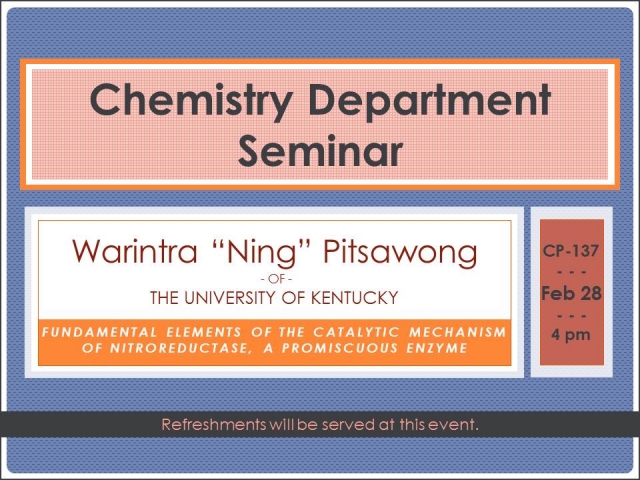----------
Warintra "Ning" Pitsawong of the UK Chemistry Department will be presenting a seminar titled:
Fundamental elements of the catalytic mechanism of Nitroreductase, a promiscuous enzyme
Abstract: The oxygen-insensitive nitroreductase from Enterobacter cloacae (NR) catalyzes two-electron reduction of nitroaromatics to the corresponding nitroso compounds and, subsequently, to hydroxylamine products. NR has an unusually broad substrate repertoire, which may be related to protein dynamics (flexibility) and/or a simple non-selective kinetic mechanism. To investigate the possible role of mechanism in NR's broad substrate repertoire, the kinetics of oxidation of NR by para-nitrobenzoic acid (p-NBA) were investigated using stopped-flow techniques at 4°C. The results revealed a hyperbolic dependence on the p-NBA concentration with a limiting rate of 1.9 ± 0.1 s-1, indicating one-step binding prior to the flavin oxidation step. There is no evidence for a distinct binding step in which specificity might be enforced. The reduction of p-NBA is rate-limiting in steady-state turnover (1.7 ± 0.3 s-1). The pre-steady-state reduction kinetics of NR by NADH indicate that NADH reduces the enzyme with a rate constant of 700 ± 20 s-1 and a dissociation constant of 0.51 ± 0.04 mM. Thus we demonstrate simple transient kinetics in both the reductive and oxidative half-reactions that help to explain NR's broad substrate repertoire.
The mechanism for nitroaromatic reduction by nitroreductase requires the transfer of two electrons and two protons overall. Electrons transfer from reduced anionic FMN, which is the cofactor of NR. One proton has been proposed to be transferred from reduced flavin (as part of hydride transfer) or transferred as a proton from solvent in electron-coupled proton transfer. The other proton must be transferred from solvent. To gain insight into the sources of protons participating in nitroaromatic reduction, X-ray crystallography has been combined with measurement of the primary and solvent kinetic isotope effects (KIEs). The transient kinetics revealed that a large primary KIE of 3.2 ± 0.2 applies to flavin reduction by NADH (reductive half-reaction) suggesting hydride transfer directly from NADH to the flavin N(5). Moreover, a primary KIE of 1.5 ± 0.05 applies to the turnover number, indicating hydride transfer from N(5) atom to p-NBA (oxidative half-reaction). The measured solvent KIEs are consistent with solvent as the source of the second proton. Thus we have been able to characterize electron transfer events via the optical signatures of the different oxidation states of the flavin, and proton transfer steps via KIE to document the fundamental steps that make up the catalized chemical reactions of NR.
Faculty Advisor: Dr. Anne-Frances Miller

